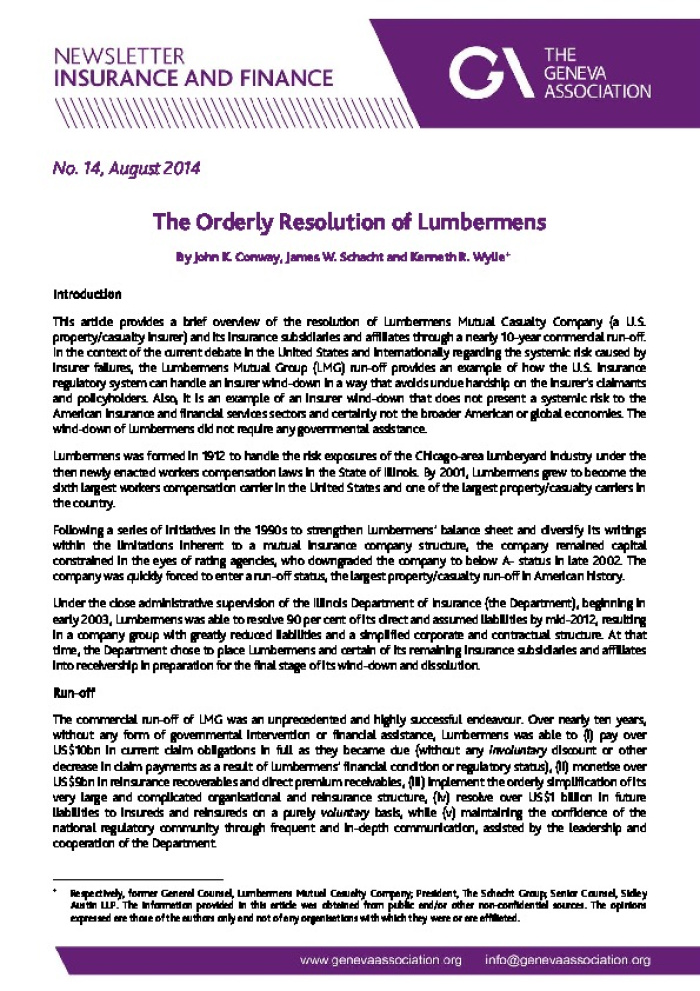The Orderly Resolution of Lumbermens
Article from Insurance and Finance Newsletter No.14-John K. Conway, James W. Schacht and Kenneth R. Wylie present the Lumbermens Mutual Group insolvency case with its innovative run-off process as a case highlighting how the U.S. insurance regulatory system can handle an insurer wind-down in a way that avoids undue hardship on the insurer's claimants and policyholders.

No. 14 , August 2014 The Orderly Resolution of Lumbermens By John K. Conway, James W. Schacht and Kenneth R. Wylie+ Introduction This article provides a brief overview of the resolution of Lumbermens Mutual Casualty Company (a U.S. property/casualty insurer) and its insurance subsidiaries and affiliates through a nearly 10 -year commercial run -off. In the context of the current debat e in the United States and internationally regarding the systemic risk caused by insurer failures, the Lumbermens Mutual Group (LMG) run -off provides an example of how the U.S. insurance regulatory system can handle an insurer wind -down in a way that avoid s undue hardship on the insurer?s claimants and policyholders. Also, it is an example of an insurer wind -down that does not present a systemic risk to the American insurance and financial services sectors and certainly not the broader American or global ec onomies. The wind -down of Lumbermens did not require any governmental assistance. Lumbermens was formed in 1912 to handle the risk exposures of the Chicago- area lumberyard industry under the then newly enacted workers compensation laws in the State of Illi nois. By 2001, Lumbermens grew to become the sixth largest workers compensation carrier in the United States and one of the largest property/casualty carriers in the country. Following a series of initiatives in the 1990s to strengthen Lumbermens? balance sheet and diversify its writings within the limitations inherent to a mutual insurance company structure, the company remained capital constrained in the eyes of rating agencies, who downgraded the company to below A - status in late 2002. The company was q uickly forced to enter a run -off status, the largest property/casualty run -off in American history. Under the close administrative supervision of the Illinois Department of Insurance (the Department), beginning in early 2003, Lumbermens was able to resolve 90 per cent of its direct and assumed liabilities by mid -2012, resulting in a company group with greatly reduced liabilities and a simplified corporate and contractual structure. At that time, the Department chose to place Lumbermens and certain of its re maining insurance subsidiaries and affiliates into receivership in preparation for the final stage of its wind -down and dissolution. Run-off The commercial run-off of LMG was an unprecedented and highly successful endeavour. Over nearly ten years, without any form of governmental intervention or financial assistance, Lumbermens was able to (i) pay over US$10bn in current claim obligations in full as they became due (without any involuntary discount or other decrease in claim payments as a result of Lumberme ns? financial condition or regulatory status), (ii) monetise over US$9bn in reinsurance recoverables and direct premium receivables, (iii) implement the orderly simplification of its very large and complicated organisational and reinsurance structure, (iv) resolve over US$1 billion in future liabilities to insureds and reinsureds on a purely voluntary basis, while (v) maintaining the confidence of the national regulatory community through frequent and in -depth communication, assisted by the leadership and c ooperation of the Department. + Respectively, former General Counsel, Lumbermens Mutual Casualty Company; President, The Schacht Group; Senior Counsel, Sidley Austin LLP. The information provided in this article was obtained from public and/or other non -confidential sources. The opinions expressed are those of the authors only and not of any organisations with which they were or are affiliated .